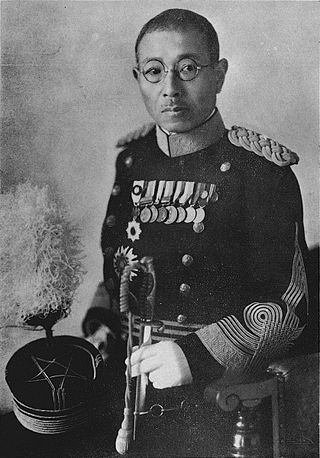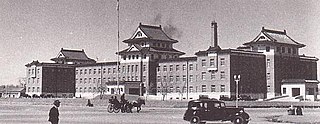
Unit 731, short for Manchu Detachment 731 and also known as the Kamo Detachment and the Ishii Unit, was a covert biological and chemical warfare research and development unit of the Imperial Japanese Army that engaged in lethal human experimentation and biological weapons manufacturing during the Second Sino-Japanese War (1937–1945) and World War II. It killed an estimated 200,000 to 300,000 people. It was based in the Pingfang district of Harbin, the largest city in the Japanese puppet state of Manchukuo and had active branch offices throughout China and Southeast Asia.

The International Military Tribunal for the Far East (IMTFE), also known as the Tokyo Trial and the Tokyo War Crimes Tribunal, was a military trial convened on 29 April 1946 to try leaders of the Empire of Japan for their crimes against peace, conventional war crimes, and crimes against humanity, leading up to and during the Second World War. The IMTFE was modeled after the International Military Tribunal (IMT) at Nuremberg, Germany, which prosecuted the leaders of Nazi Germany for their war crimes, crimes against peace, and crimes against humanity.

Otozō Yamada was a career officer, convicted war criminal and general in the Imperial Japanese Army, serving from the Russo-Japanese War to the end of World War II.

Unit 100 was an Imperial Japanese Army facility called the Kwantung Army Warhorse Disease Prevention Shop that focused on the development of biological weapons during World War II. It was operated by the Kempeitai, the Japanese military police. Its headquarters was located in Mokotan, Manchukuo, a village just south of the city of Changchun. It had branches in Dairen and Hailar. The Hailar branch was later transferred to Foshan. Between 600 and 800 people worked at Unit 100.
Zhongma Fortress — also Zhong Ma Prison Camp or Unit Tōgō — was a prison camp where the Japanese Kwantung Army carried out covert biological warfare research on human test subjects. Built in Beiyinhe, outside of Harbin, Manchukuo during the Second Sino-Japanese War, the camp served as a center for human subject experimentation and could hold up to 1,000 prisoners at any given time. In 1937 the prison camp was destroyed and testing operations were transferred to Pingfang under Unit 731.

Surgeon General Shirō Ishii was a Japanese war criminal, microbiologist and army medical officer who was the director of Unit 731, a biological warfare unit of the Imperial Japanese Army. Ishii led the development and application of biological weapons at Unit 731 in Manchukuo during the Second Sino-Japanese War from 1937 to 1945, including the bubonic plague attacks at Chinese cities of Changde and Ningbo, and planned the Operation Cherry Blossoms at Night biological attack against the United States.

War crimes in Manchukuo were committed during the rule of the Empire of Japan in northeast China, either directly, or through its puppet state of Manchukuo, from 1931 to 1945. Various war crimes have been alleged, but have received comparatively little historical attention.

The Kaimingjie germ weapon attack was a secret biological warfare launched by Japan in October 1940 against the Kaiming Street area of Ningbo, Zhejiang, China. A joint operation of the Imperial Japanese Army's Unit 731 and Unit 1644, this attack was operated by military planes taking off from Jianqiao Airport in Hangzhou,which airdropped wheat, corn, cotton scraps, and sand infected with plague fleas to target locations. From September 1940, Ningbo, Quzhou, and other places were subjected to various forms of biological warfares until the end of October 1940, when the attacks triggered a plague epidemic in Ningbo.

Kurt Blome was a high-ranking Nazi scientist before and during World War II. He was the Deputy Reich Health Leader (Reichsgesundheitsführer) and Plenipotentiary for Cancer Research in the Reich Research Council. In his autobiography Arzt im Kampf, he equated medical and military power in their battle for life and death.
Unit Ei 1644 — also known as Unit 1644, Detachment Ei 1644, Detachment Ei, Detachment Tama, The Nanking Detachment, or simply Unit Ei, was a Japanese laboratory and biological warfare facility under control of the Epidemic Prevention and Water Purification Department. It was established in 1939 in Japanese-occupied Nanjing as a satellite unit of Unit 731. It had 12 branches and employed about 1,500 men.

Tetsuzan Nagata was a Japanese military officer and general of the Imperial Japanese Army best known as the victim of the Aizawa Incident in August 1935.

Unit Oka 9420, also known as the Epidemic Prevention and Water Purification Department of the Southern Expeditionary Army Group, was a disease research unit within the Japanese army. Founded in Nanjing, China in 1942 and headquartered in Japanese-occupied Singapore, the unit had branches in Malaya, Indonesia, the Philippines, Papua New Guinea, Thailand, and Burma, and participated in bacteriological weapons attacks in northern Burma, Yunnan, China, and Papua New Guinea. With a suitable, tropical climate suitable bed for the breeding of rat fleas, Malaya was the largest rat flea farms outside of Japan and China during World War II. The unit left Singapore in mid-1945 and dissolved in 1946.

John William Powell was a journalist and small business proprietor who edited the China Weekly Review, an English-language journal first published by his father, John B. Powell in Shanghai.
The Epidemic Prevention and Water Purification Department was a department of the Imperial Japanese Army from 1936 to the dissolution of the Army in 1945. While its public mission was to prevent the spread of disease and monitor water supply, several field armies also assigned units the mission of manufacturing biological weapons. Many units also performed unethical human experimentation, such as Unit 731, in which thousands of prisoners of war and civilians were tortured to death over the course of years.
Shunji Satō was a Japanese physician during the first half of the 20th century, a major general in the Imperial Japanese Army, and a convicted war criminal.

Masaji Kitano was a Japanese war criminal, medical physician, microbiologist and a lieutenant general in the Imperial Japanese Army.

Allegations that the United States military used biological weapons in the Korean War were raised by the governments of the People's Republic of China, the Soviet Union, and North Korea. The claims were first raised in 1951. The story was covered by the worldwide press and led to a highly publicized international investigation in 1952. Secretary of State Dean Acheson and other American and allied government officials denounced the allegations as a hoax. Subsequent scholars are split about the truth of the claims.

The Kwantung Army was a general army of the Imperial Japanese Army from 1919 to 1945.
Operation PX, also known as Operation Cherry Blossoms at Night, was a planned Japanese military attack on civilians in the United States using biological weapons, devised during World War II. The proposal was for Imperial Japanese Navy submarines to launch seaplanes that would deliver weaponized bubonic plague, developed by Unit 731 of the Imperial Japanese Army, to the West Coast of the United States. The operation was abandoned shortly after its planning was finalized in March 1945 due to the strong opposition of General Yoshijirō Umezu, Chief of the Army General Staff.
The NKVD special camp No. 48 was located in Cherntsy, Ivanovo Oblast. Russia. Initially it was established during World War II as a POW camp for most senior military commanders of the Axis powers. In German sources it is known as Kriegsgefangenenlager Woikowo, the latter location translated in English as Voikovo. Later it housed a secret Soviet biological weapons facility.













